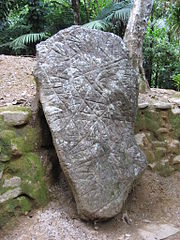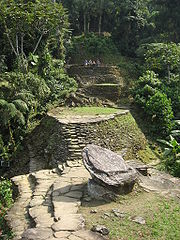- Ciudad Perdida
-
Ciudad Perdida (Spanish for "Lost City") is the archaeological site of an ancient city in Sierra Nevada, Colombia. It is believed to have been founded about 800 AD, some 650 years earlier than Machu Picchu. This location is also known as Buritaca and the Native Americans call it Teyuna.
Ciudad Perdida was discovered in 1972, when a group of local treasure looters found a series of stone steps rising up the mountainside and followed them to an abandoned city which they named "Green Hell" or "Wide Set". When gold figurines and ceramic urns from this city began to appear in the local black market, authorities revealed the site in 1975.
Members of local tribes—the Arhuaco, the Koguis and the Asario—have stated that they visited the site regularly before it was widely discovered, but had kept quiet about it. They call the city Teyuna and believe it was the heart of a network of villages inhabited by their forebears, the Tairona. Ciudad Perdida was probably the region's political and manufacturing center on the Buritaca River and may have housed 2,000 to 8,000 people. It was apparently abandoned during the Spanish conquest.
Ciudad Perdida consists of a series of 169 terraces carved into the mountainside, a net of tiled roads and several small circular plazas. The entrance can only be accessed by a climb up some 1,200 stone steps through dense jungle.
Unfortunately, the area was at one time affected by the Colombian armed conflict between the Colombian National Army, right-wing paramilitary groups and left-wing guerrilla groups like National Liberation Army (ELN) and Revolutionary Armed Forces of Colombia (FARC). On September 15, 2003, ELN kidnapped 8 foreign tourists that were visiting Ciudad Perdida, demanding government investigation of human rights abuses in exchange for their hostages. ELN released the last of the hostages three months later. The AUC paramilitary group declared itself protector of this area. The Colombian Institute of Anthropology avoided the area after the kidnappings occurred and access to tourists was also restricted.[citation needed]
In 2005, tourist hikes became operational again. The Colombian army actively patrols the area, which is now deemed to be very safe for visitors and there have not been any more kidnappings. For a 6 day return hike to the lost city, the cost is approximately US$300. The hike is about 44 km of walking in total, and requires a good level of fitness. The hike includes a number of river crossings and steep climbs and descents. It is a moderately difficult hike.
Since 2009, non-profit organization Global Heritage Fund (GHF) has been working in Ciudad Perdida to preserve and protect the historic site against climate, vegetation, neglect, looting, and unsustainable tourism. GHF's stated goals include the development and implementation of a regional Management Plan, documentation and conservation of the archaeological features at Ciudad Perdida and the engagement of the local indigenous communities as major stakeholders in the preservation and sustainable development of the site.
References
- Toby Muse - Lost City (Archaeology magazine September/October 2004)
External links
- Info about The Lost City - Off 2 Colombia -
- The Lure of Colombia's Lost City by Mark Henderson, The Guardian, October 24, 2009
- La Ciudad Perdida (The Lost City) by Darren Crawford
- Ciudad Perdida Preservation Project by Global Heritage Fund
- Explore Ciudad Perdida with Google Earth on Global Heritage Network
Coordinates: 11°2′16.79″N 73°55′30.69″W / 11.0379972°N 73.9251917°W
 Ciudad Perdida | El Abra | El Infiernito | El morro del tulcán | Malagana | Monsu | Puerto Hormiga archaeological site | San Agustín, Huila | TierradentroCategories:
Ciudad Perdida | El Abra | El Infiernito | El morro del tulcán | Malagana | Monsu | Puerto Hormiga archaeological site | San Agustín, Huila | TierradentroCategories:- Archaeological sites in Colombia
- Former populated places in Colombia
- Archaeology of Colombia
- 1972 archaeological discoveries
Wikimedia Foundation. 2010.


